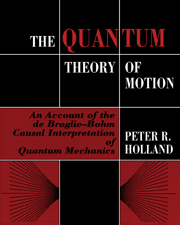 The Quantum Theory of Motion
The Quantum Theory of Motion Book contents
- Frontmatter
- Contents
- Preface
- 1 Quantum mechanics and its interpretation
- 2 Hamilton–Jacobi theory
- 3 Elements of the quantum theory of motion
- 4 Simple applications
- 5 Interference and tunnelling
- 6 The classical limit
- 7 Many-body systems
- 8 Theory of experiments
- 9 Spin ½: the Pauli theory
- 10 Spin ½: the rigid rotator
- 11 The Einstein–Podolsky–Rosen experiment and nonlocality
- 12 Relativistic quantum theory
- References
- Index
2 - Hamilton–Jacobi theory
Published online by Cambridge University Press: 20 January 2010
- Frontmatter
- Contents
- Preface
- 1 Quantum mechanics and its interpretation
- 2 Hamilton–Jacobi theory
- 3 Elements of the quantum theory of motion
- 4 Simple applications
- 5 Interference and tunnelling
- 6 The classical limit
- 7 Many-body systems
- 8 Theory of experiments
- 9 Spin ½: the Pauli theory
- 10 Spin ½: the rigid rotator
- 11 The Einstein–Podolsky–Rosen experiment and nonlocality
- 12 Relativistic quantum theory
- References
- Index
Summary
The need for a common language
If we wish to compare the methods, content, claims and experimental predictions of two physical theories we have to find some common ground between them. What is needed ideally is a language which embraces the essential elements of each theory as parts of a broader structure which transcends them both. There are two components to such a language, which might be called the formal and the informal. Briefly, by ‘formal’ we mean a precisely defined set of concepts and their relationships from which one can deduce unambiguous conclusions by a series of logical steps (mathematics); by ‘informal’ we mean the intuitive concepts and pictures that a theory employs in order to render intelligible the ‘reality’ for which it seeks to account. These two aspects are naturally closely connected. The possibility of constructing a language of this type is not given a priori. It may turn out that it is possible to develop only one of the two components, and the theories we want to compare may or may not be commensurable, or only partly so.
We shall examine this question in connection with the relation between two physical theories of matter: classical mechanics and quantum mechanics. This relation is subtle and operates on several levels and we shall return to it throughout the book. For the present we confine ourselves to some general remarks. Roughly speaking, we may say that classical mechanics as a distinct discipline constitutes a language possessing both formal and informal aspects.
Information
- Type
- Chapter
- Information
- The Quantum Theory of MotionAn Account of the de Broglie-Bohm Causal Interpretation of Quantum Mechanics, pp. 27 - 65Publisher: Cambridge University PressPrint publication year: 1993